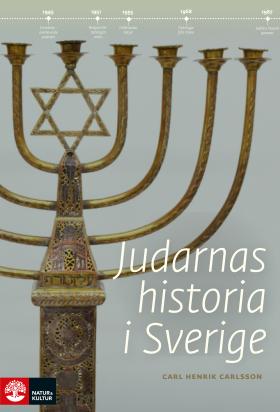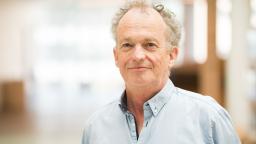
Judarnas historia i Sverige
(The history of the Jews in Sweden)
by Carl Henrik Carlsson
reviewed by Kate Lambert
An early chapter in Carl Henrik Carlsson’s thorough chronological account is entitled ‘Why are there no synagogues in Sweden?’, a question asked by Jacob Wallenberg, ship’s priest for the Swedish East India Company in 1769. Readers unfamiliar with Sweden’s Jewish history may well wonder why this was the case too. The answer is provided by an overview of medieval antisemitism and of the attitudes towards Jews of Swedish rulers from Oxenstierna (negative) and Queen Kristina (positive) in the seventeenth century up to the reign of Gustav III. The following chapter is introduced by a description of the lamenting crowds on the quayside in Stralsund in 1774 as ‘Sweden’s first Jew’, Aaron Isaac, sailed for Sweden. Within a year he had obtained a permit for him and a few others to reside permanently in Sweden without having to abandon his religion.
Each chapter begins with a snapshot of a similar key event, bringing them to life. In chapter 6 we follow Jacob Ettlinger, a businessman in the early twentieth century, walking several kilometres from his home in fashionable north Stockholm near the reform synagogue to attend the orthodox synagogue in the workers’ district of Södermalm, demonstrating that the boundaries between class, place of origin and type of worship were not as rigid as might have been assumed. The very first chapter, entitled ‘Aaron Isaac is old and bitter’, begins with Isaac writing a letter to his fellow members of the Stockholm Jewish community in 1807. Serving as an introductory chapter before the historical account begins, it highlights themes that recur throughout the book: relations and tensions between Sweden’s Jews as a whole and the Swedish state, including antisemitism and rigid restrictions, as well as such differences within Sweden’s Jewish communities. Sweden’s Jews never have been a homogenous group and throughout the book issues arise between established communities and each wave of new arrivals.
The subsequent chronological chapters take us through the period 1774–1838, in which the early pioneers arrived in Sweden with limited rights and settlement restricted to a few specific towns, before covering emancipation and reformed Judaism in 1838–1870, and in 1870–1917, the eventual emergence of a Jewish elite and a second-generation Jewish community contrasted with a new wave of ‘östjudisk’ Jewish immigration from the Russian Empire, many of whom initially earned a living as peddlers. There is a short chapter on the period before 1933, and a necessarily longer one on 1933–1948. The final chapters look at revitalisation, memoirs of the Holocaust and new waves of immigration from Eastern Europe, and the book concludes with the period 1991–2021 in which Jews became one of Sweden’s official national minorities, with Yiddish a national minority language, and Stockholm gained its first female rabbi in Ute Steyer.
This is an extremely thorough history, covering a huge range of subjects and themes. Carl Henrik Carlsson appears as a regular expert on the Swedish version of ‘Who do you think you are?’. The division into periods and the contents page including section headings makes it easy to locate a particular topic, such as ‘The Jews in Norrköping before 1838’, ‘Jewish family life before 1870’, ‘Zionism in Sweden before 1933’, or ‘Identification, antisemitism and relations with Israel after 1967’. Many of the chapters name individuals whose life stories, with quotes and, in the later chapters, photographs, bring this vast amount of detailed data to life. Often their contribution to Swedish life, culture, society or industry is highlighted. For example, the section on the refugees from Nazi Germany in the 1930s includes Georg Riedel, who arrived in Sweden aged four in 1938 and went on to compose music for many of Astrid Lindgren’s texts, including ‘Idas sommarvisa’, sung at the end of term in Swedish schools.
In the section on the Second World War and the Holocaust, these personal stories become even more poignant. There are Solveig Levin and three-year-old Mona who, with nine others, walked for three hours in the pitch dark at minus 18⁰C to cross into Sweden from occupied Norway. There is an eye-witness description of the women from Ravensbrück arriving in Sweden on the Red Cross ‘white buses’ in spring 1945 and the words of Eva Pomeranz, a few weeks after arriving at Doverstorp refugee camp: ‘For me the war is not won. My family have been killed, I am alone in the world and own nothing, for me the war is lost!’
The book ends with a 4-page index of organisations past and present and a 9-page index of names mentioned, making it a useful resource for students of Jewish history and family history researchers. Terms that may be unfamiliar to non-Jewish readers are explained the first time they appear and there is also a glossary at the end of the book. Sources are cited in the text and there is a list of references for further reading. This thorough work is a detailed resource for anyone interested in Jewish history, Jewish history in Sweden, and in Swedish history and society over the past three centuries.

Judarnas historia i Sverige
Natur & Kultur, 2021.
400 pages.
Foreign rights: Natur & Kultur
Dr Carl Henrik Carlsson is a researcher at the Hugo Valentin Centre at Uppsala University, specialising in Jewish history.
In 2021 the book was nominated for the August Prize in the non-fiction category and for the Great Non-Fiction Book Prize.
